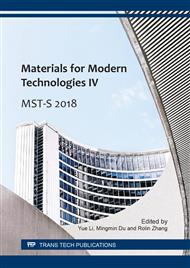[1]
Li B, Zhang S H, Zhang G L, Zhang H Q. Prediction of 3-D temperature field of TP2 copper tubes in three-roll planetary rolling process[J]. journal of materials processing technology, 2008, 205(1): 370-375.
DOI: 10.1016/j.jmatprotec.2007.11.213
Google Scholar
[2]
LI B, Zhang S H, Zhang G L, Zhang H Y , Zhang H Q. Microstructure simulation of copper tube and its application in three roll planetary rolling[J]. Materials science and technology, 2007, 23(6): 715-722.
DOI: 10.1179/174328407x185848
Google Scholar
[3]
Zhang J H. The application of casting-rolling procedure in technology for processing copper coll tube[J]. Hunan Metallurgy, 2004, 5: 39-41.
Google Scholar
[4]
Deng C, Huang B, Su Y C, Liu D H. Study on the psw cast-roll proccess in the producation of the acr copper tubes[J]. Hunan Metallurgy, 2006, 5: 3-6.
Google Scholar
[5]
Wang J, Yun X, Li B,Fan Z X. Microstructure evolution of copper during continuous extrusion process[J]. Nonferrous Metals (Extractive Metallurgy), 2011, 5: 38-41.
Google Scholar
[6]
K H Song, H J Lee, W Y Kim. Enhanced Mechanical Properties and Formability of Cross-Roll Rolled Ni–10Cr Alloy[J]. Materials Transactions, 2012, 53(5): 1011-1016.
DOI: 10.2320/matertrans.m2011392
Google Scholar
[7]
Ding Y T, Liu B, Guo T.B, Hu Y, Li H.L, Zhao J.Y. Dislocation density variation and mechanical properties of pure copper via equal channel angular pressing[J],Chinese Journal of nonferrous metals,2014,24(08):2057-(2064).
Google Scholar
[8]
Lu L.P, Yun X B, Yang J.Y, Song B.Y. Study on Deforming Behavior of Copper-Magnesium Alloy Wire in Extending Continuous-extrusion Process[J]. Hot Working Technology, 2010, 39:92-95.
Google Scholar
[9]
Chapman V, Welch B J, Skyllas-Kazacos M. High temperature oxidation behaviour of Ni–Fe–Co anodes for aluminium electrolysis[J]. Corrosion Science, 2011, 53(9): 2815-2825.
DOI: 10.1016/j.corsci.2011.05.018
Google Scholar
[10]
Zeng H.N, He Y.D, Xing S.Y, Li Z.J, Liu X.Y, He M.G. Kinetics of Melting Loss and Evaporation Process of Cu-Zn Alloy[J],CHINESE JOURNAL OF RARE METALS, 201741(03):267-275.
Google Scholar
[11]
Ouvarov-Bancalero V, Guay D, Roué L. Mechanically alloyed Cu-Ni-Fe-Y material as inert anode for Al production[M]//Light Metals 2013. Springer, Cham, 2016: 1277-1281.
DOI: 10.1002/9781118663189.ch215
Google Scholar
[12]
He Y D, Zhang X M, You J H. Effect of minor Sc and Zr on microstructure and mechanical properties of Al-Zn-Mg-Cu alloy[J]. Transactions of Nonferrous Metals Society of China, 2006, (05): 1228-1235.
DOI: 10.1016/s1003-6326(06)60406-8
Google Scholar
[13]
Taher A M, Jarjoura G, Kipouros G J. Effect of iron as alloying element on electrochemical behaviour of 90: 10 Cu–Ni alloy[J]. Canadian Metallurgical Quarterly, 2011, 50(4): 425-438.
DOI: 10.1179/000844311x13117643274758
Google Scholar
[14]
Zhang C.W, He Y.D, Chen C, Xing S Y, Zeng H N, Liu X Y, He M G, Li Z J. Study on Effect of Melting Protection of Different Covering Agent in Pure Copper Melting Process[J].FOUNDRY TECHNOLOGY,2017,38(01):122-127.
Google Scholar
[15]
Xing S Y, He Y D , Zeng H N, Li Z J, Liu X Y, He M G.Mechanism of Protective Cover and Melting Loss of Copper Melt[J]. CHINESE JOURNAL OF RARE METALS, 2017, 41(06):684-692.
Google Scholar
[16]
Donoso E. Kinetic study of the annealing reactions in Cu-Ni-Fe alloys[J]. Revista de Metalurgia, 2014, 50(3): 1-5.
Google Scholar
[17]
Heino P, Perondi L, Kaski K, Ristolainen E. Stacking-fault energy of copper from molecular-dynamics simulations[J]. Physical Review B, 1999, 60(21): 14625.
DOI: 10.1103/physrevb.60.14625
Google Scholar
[18]
Li Y, Korzhavyi P A. Interactions of point defects with stacking faults in oxygen-free phosphorus-containing copper[J]. Journal of Nuclear Materials, 2015, 462: 160-164.
DOI: 10.1016/j.jnucmat.2015.03.041
Google Scholar
[19]
Yun X B, You W, Zhao Y, Li B, Fan Z X. Continuous extrusion and rolling forming velocity of copper strip[J]. Transactions of Nonferrous Metals Society of China, 2013, 23(4): 1108-1113.
DOI: 10.1016/s1003-6326(13)62572-8
Google Scholar
[20]
Galkin A, Dyja H, Dubovtsev I, Laber K. Analiza zapasu plastyczności stopów typu Cu-Ni-Fe-Mn odkształcanych w warunkach walcowania na zimno i wielokrotnego ciągnienia rur w ciągarkach bębnowych[J]. Hutnik, Wiadomości Hutnicze, 2011, 78(5): 376-381.
DOI: 10.15199/24.2015.4.5
Google Scholar


